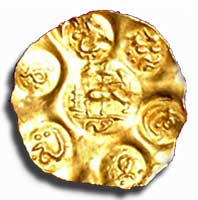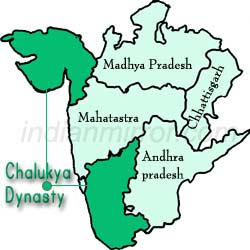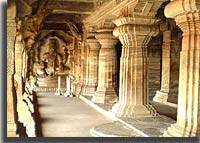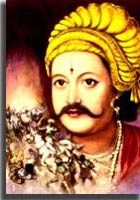History :
The dynasty was empire that ruled the Deccan region of India. After fading away for some time they revived they power back during the 10th century and ruled till 12th century. Chalukyas the one who ruled from Badami were the Western Chalukyas, from Kalyani are referred as Later Western Chalukyas and the Chalukyas one from Vengi are known to the historians as the Eastern Chalukyas.
The Society in Chalukyan rule was divided into four castes like Brahmanas, Kshatriyas, Vaishyas and Sudras. Brahamans were very much busy doing works like priests, teachers and Religious propagators. Mostly the minister was Brahmans. The traders were the Vaishyas. And the farmer was under the caste called Sudras. Among all of them the Kshatriyas formed the ruling class.
The caste system in Chalukyan rule was very much rigid and they were divided into sub-castes also. Marriages between the same gotras was strictly prohibited. Inter-caste marriage was not allowed. Mostly the weddings was arranged by the parents and sometime girls were given liberty to select the husband. Women secured great respect in the society and they could sacrifice everything for the sake of the prestige.
People

During the reign of Chalukyas the religion of Shaiva was in great progress. In this period the king was called the "Umapativarlabdh". Temple of Siva was built by kings in this period. And even the broken temples of Somnath were also rebuilt. The construction of Eka Sahastraling Talaba temple by building the four sides of the temple was also done during this period.
Administration
In Indian history, the history of Karnataka extends more than two thousand years. Many dynasties came to power during these centuries and Chalukyas are one of the greatest of these. Twice in the Indian history of Karnataka they were prominent.
Pulakesin-I
Under Jayasimha and his son Ranaraga, Chalukyas ruled from about 535 to 566 AD. But the dynasty is known to be founded by the Maharaja Pulakesin-I. Pulakesi-I had given titles such as Satyasraya and was a scholar too. No conquests are credited to him, but he is stated to have ruled from Badami, the present day Bijapur.

Place |
Gujarat/Karnataka (Southern India) |
Period |
6th to 8th & 10th to 12th century |
Language |
Kannada, Sanskrit |
Religion |
Hinduism, Jainism |
Kings |
Pulakesi I, Kirtivarman II |
Kritivirman - I
Kritivirman - I, the son of Pulakesin – I ascended the throne after him. He constructed many temples and buildings in the town of Vatapi. The political influence of Chalukya dynasty spread over a wider region embracing southern part of Maharastra, Mysore and Tamilnadu. Kritivirman- - I defeated the rulers of Vanga, Anga, Kalinga, Vattura, Magadha.
Mangalesa
Mangalesa, another son of Pulakesin – I and the brother of Kritivirman-I ascended the throne in 598 AD. Mangalesa conquered and the whole of central and northern Maratha country was brought into the territory. The eventual civil war between Mangalesa and his nephew Pulakesi-II cost Mangalesa his own life.
Pulakesin-II
Pulakesin – II ascended the throne from 610 AD to 642 AD. Ruling reign was not easy as the bed of roses for him; various parts of Chalukyas got independence. The extreme rebellion and the frequent invasion by Appayika and Govinda were at last subdued. Pulakesin- II made Gangas of south Mysore to submit and Mauryas of Konkan were defeated. As he conquered these he was into contact with Harsha and again in 637 AD Harsha was defeated when he had invaded Kathiawad. Pulakesin – II also defeated Pallava king Mahendra Varman -I, and crossed the Cauvery river. He made friendship with the Cholas, Cheras and Pandyas. As Pallavas were not totally crushed, they took revenge and attacked Pulakesin-II. He appears to have been killed in the battle, and then Chalukya Empire began to decline. The Chalukya dynasty is well known for developing and encouraging art and architecture during its era. The rulers during this period were great enthusiasts of art. We get evidence from the fact that they built many temples near the region of Badami. A famous attempt of their architecture is the Virupaksha Temple in Karnataka. The sculptures of the temples are beautifully carved and sculpted and represent scenes from the famous epic Ramayana. Some of the paintings at Ajanta and Ellora cave temple also belong to this period.

Vikramaditya - I
 | Pulakesin-II death gave a way to take up the throne by Vikramaditya-I from 642 AD - 655 AD. He recovered Badami and brought the whole kingdom under his control. |
Vinayaditya
Vinayaditya ruled from 681 to 696 AD and battled against the Cholas, Pandyas, Pallavas, Aluvas. By defeating the Lord of the entired Uttarapatha, he acquired the banner Palidhvaja. After him the successor Vijayaditya ruled for nearly 40 years (696 AD - 733 AD).
Vikramaditya - II
Vikaramaditya-II was a son of Vijayaditya. He ruled from 734 AD - 745 AD. He defeated the Pallava king thus putting off the continuing hostilities. With this conquest, he took possession of musical instruments, banners, elephants, rubies which belonged to the Pallavas. He destroyed the power of the Chola, Chera, and Pandya.
Kritivarman - II
The son of Vikramaditya-II, for the next eleven years Kritivarman-II took over the kingdom and ruled. He was the last glorious ruler of Chalukyas. Later for the further 50 years, the Chalukya power was totally eclipsed by the Rashtrakutas. The King Dantidurga defeated Kritivarman-II to gain the control of Chalukyas once for all.


